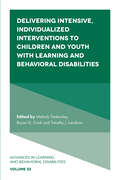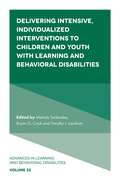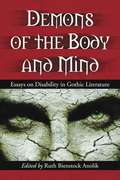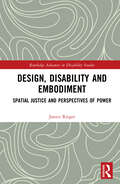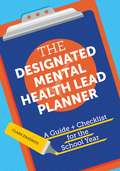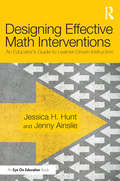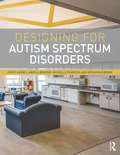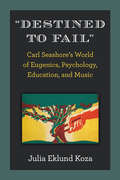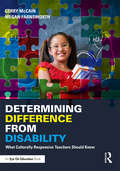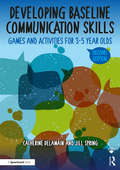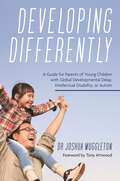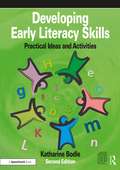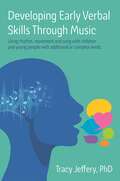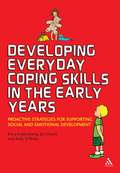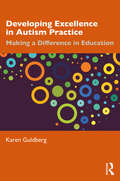- Table View
- List View
Delivering Intensive, Individualized Interventions to Children and Youth with Learning and Behavioral Disabilities (Advances in Learning and Behavioral Disabilities #32)
by Melody Tankersley, Bryan G. Cook, Timothy J. LandrumIntensive, individualized interventions are certainly the hallmark promise of special education. In a multi-tiered system of supports (MTSS), tier 3 interventions are the most intensive and require individualized delivery to address the learning and behavioral needs of students who are most often identified for special education services. MTSS, such as Responsiveness to Intervention (RTI) and Positive Behavioral Interventions and Supports (PBIS), are comprised of universal assessment, progress monitoring, and databased decision-making as intervention is implemented with increasing intensity and individualization based on the needs of the learner. The chapters in this volume cover a broad range of topics that address issues surrounding the identification of students who need the most intensive intervention, intensive intervention features and delivery considerations, behavioral interventions, academic interventions, and preservice teacher preparation. The authors of the chapters are recognized as international experts on these topics and provide specific recommendations that are based on research evidence as well as discuss considerations for future enhancement of multi-tiered systems of supports and intensive interventions. This is a contemporary resource for teachers, administrators, and teacher-educators who are charged with delivering special education and/or supporting those who do.
Delivering Intensive, Individualized Interventions to Children and Youth with Learning and Behavioral Disabilities (Advances in Learning and Behavioral Disabilities #32)
by Melody Tankersley Bryan G. Cook Timothy J. LandrumIntensive, individualized interventions are certainly the hallmark promise of special education. In a multi-tiered system of supports (MTSS), tier 3 interventions are the most intensive and require individualized delivery to address the learning and behavioral needs of students who are most often identified for special education services. MTSS, such as Responsiveness to Intervention (RTI) and Positive Behavioral Interventions and Supports (PBIS), are comprised of universal assessment, progress monitoring, and databased decision-making as intervention is implemented with increasing intensity and individualization based on the needs of the learner. The chapters in this volume cover a broad range of topics that address issues surrounding the identification of students who need the most intensive intervention, intensive intervention features and delivery considerations, behavioral interventions, academic interventions, and preservice teacher preparation. The authors of the chapters are recognized as international experts on these topics and provide specific recommendations that are based on research evidence as well as discuss considerations for future enhancement of multi-tiered systems of supports and intensive interventions. This is a contemporary resource for teachers, administrators, and teacher-educators who are charged with delivering special education and/or supporting those who do.
Demons Of The Body And Mind: Essays On Disability In Gothic Literature
by Ruth Bienstock AnolikThe Gothic mode, typically preoccupied by questions of difference and otherness, consistently imagines the Other as a source of grotesque horror. The sixteen critical essays in this collection examine the ways in which those suffering from mental and physical ailments are refigured as Other, and how they are imagined to be monstrous. Together, the essays highlight the Gothic inclination to represent all ailments as visibly monstrous, even those, such as mental illness, which were invisible. Paradoxically, the Other also becomes a pitiful figure, often evoking empathy. This exploration of illness and disability represents a strong addition to Gothic studies.
Design, Disability and Embodiment: Spatial Justice and Perspectives of Power (Routledge Advances in Disability Studies)
by Janice RiegerThis timely book explores the spatial and social injustices within our streets, malls, schools, and public institutions. Taken-for-granted acts like going for a walk, seeing an exhibition with a friend, and going to school are, for people with disabilities, conditional or precluded acts due to exclusion by design. This book stimulates debate and discussion about current practice and studies in spatial design in the context of disability and the growing need for inclusive design globally. Case studies of inclusive design in spaces like museums, malls, galleries and universities are presented to challenge and expose the perspectives of power and spatial injustices that still exist within these spaces today. The international case studies presented purposely privilege the voices and perspectives of people with disabilities, to expose the multisensorial perspectives of spatial justice in order to understand inclusion more holistically through embodiment. If you are an architect, designer, arts educator, curator or museum professional or just want a world where spatial justice is possible, then this book will provide you with a new perspective of spatial design through critical disability studies, allyship and codesign, where tangible approaches and practices for inclusive design are explored.
Design, Disability and Embodiment: Spatial Justice and Perspectives of Power (Routledge Advances in Disability Studies)
by Janice RiegerThis timely book explores the spatial and social injustices within our streets, malls, schools, and public institutions. Taken-for-granted acts like going for a walk, seeing an exhibition with a friend, and going to school are, for people with disabilities, conditional or precluded acts due to exclusion by design. This book stimulates debate and discussion about current practice and studies in spatial design in the context of disability and the growing need for inclusive design globally. Case studies of inclusive design in spaces like museums, malls, galleries and universities are presented to challenge and expose the perspectives of power and spatial injustices that still exist within these spaces today. The international case studies presented purposely privilege the voices and perspectives of people with disabilities, to expose the multisensorial perspectives of spatial justice in order to understand inclusion more holistically through embodiment. If you are an architect, designer, arts educator, curator or museum professional or just want a world where spatial justice is possible, then this book will provide you with a new perspective of spatial design through critical disability studies, allyship and codesign, where tangible approaches and practices for inclusive design are explored.
The Designated Mental Health Lead Planner: A Guide and Checklist for the School Year
by Clare ErasmusThis planner provides detailed guidance on what a Designated Mental Health Lead needs to do, when they need to do it, and how they can achieve the best results. It gives a clear focus and checklist for each week, including spaces to add your own to-do list, and encourages reflection on the outcomes and impact of your actions on pupils' attainment and wellbeing. It also encourages a focus on your own development and self-care, with space to record what you are currently reading or listening to and one thing you are grateful for that week.In addition to the termly and weekly plans, the book provides short briefs on key aspects of the role, including how to work effectively with teachers, the HR team, the DSL, governors, the pastoral team, Mental Health Support Teams and parents. It is an invaluable resource for all DMHLs tackling the 39 academic weeks.
Designing Effective Math Interventions: An Educator's Guide to Learner-Driven Instruction
by Jessica H. Hunt Jenny AinslieDesign effective, learner-driven math interventions with this accessible and thought-provoking guidebook. Learn how to set up instruction to promote participation and understanding, plan purposeful, targeted tasks, develop student thinking, and create tools to assess student work in a way that measures learning, not just performance. Chapters explore questions that educators frequently struggle with when designing interventions, offering user-friendly research and evidence-based strategies to help overcome common hurdles. This book is essential reading for anyone seeking an adaptive approach to Tier 2 and 3 interventions that positions struggling students as competent learners.
Designing Effective Math Interventions: An Educator's Guide to Learner-Driven Instruction
by Jessica H. Hunt Jenny AinslieDesign effective, learner-driven math interventions with this accessible and thought-provoking guidebook. Learn how to set up instruction to promote participation and understanding, plan purposeful, targeted tasks, develop student thinking, and create tools to assess student work in a way that measures learning, not just performance. Chapters explore questions that educators frequently struggle with when designing interventions, offering user-friendly research and evidence-based strategies to help overcome common hurdles. This book is essential reading for anyone seeking an adaptive approach to Tier 2 and 3 interventions that positions struggling students as competent learners.
Designing for Autism Spectrum Disorders
by Angela Bourne Michelle Pearson Kristi Gaines Mesha KleibrinkWinner of the 2017 IDEC Book Award, 2017 EDRA Great Places Award (Book Category), 2017 American Society of Interior Designers Joel Polsky Prize and the 2016 International Interior Design Association TXOK Research Award Designing for Autism Spectrum Disorders explains the influence of the natural and man-made environment on individuals with autism spectrum disorders (ASD) and other forms of intellectual/developmental disabilities (IDD). Drawing on the latest research in the fields of environmental psychology and education, the authors show you how architecture and interior spaces can positively influence individuals with neurodiversities by modifying factors such as color, lighting, space organization, textures, acoustics, and ventilation. Now you can design homes, therapeutic environments, work environments, and outdoor spaces to encourage growth and learning for the projected 500,000 children with ASD (in the United States alone) who are expected to reach adulthood by 2024. Topics discussed include:-Environmental design theories-Symptoms of ASD-Sensory processing deficits -Design needs of individuals on the spectrum at all ages-Design methods and solutions for spaces, including residential, learning, work, and therapeutic environments encompassing a wide range of budgets-Designing for self-actualization, well-being, and a high quality of life for the duration of an individual's life-Avenues for healthy living and aging in place-Biophilic design-Environmental impact on well-being -Strategies to promote active living as an integral part of the welfare focus.
Designing for Autism Spectrum Disorders
by Angela Bourne Michelle Pearson Kristi Gaines Mesha KleibrinkWinner of the 2017 IDEC Book Award, 2017 EDRA Great Places Award (Book Category), 2017 American Society of Interior Designers Joel Polsky Prize and the 2016 International Interior Design Association TXOK Research Award Designing for Autism Spectrum Disorders explains the influence of the natural and man-made environment on individuals with autism spectrum disorders (ASD) and other forms of intellectual/developmental disabilities (IDD). Drawing on the latest research in the fields of environmental psychology and education, the authors show you how architecture and interior spaces can positively influence individuals with neurodiversities by modifying factors such as color, lighting, space organization, textures, acoustics, and ventilation. Now you can design homes, therapeutic environments, work environments, and outdoor spaces to encourage growth and learning for the projected 500,000 children with ASD (in the United States alone) who are expected to reach adulthood by 2024. Topics discussed include:-Environmental design theories-Symptoms of ASD-Sensory processing deficits -Design needs of individuals on the spectrum at all ages-Design methods and solutions for spaces, including residential, learning, work, and therapeutic environments encompassing a wide range of budgets-Designing for self-actualization, well-being, and a high quality of life for the duration of an individual's life-Avenues for healthy living and aging in place-Biophilic design-Environmental impact on well-being -Strategies to promote active living as an integral part of the welfare focus.
"Destined to Fail": Carl Seashore’s World of Eugenics, Psychology, Education, and Music
by Julia KozaA little-known fact about the prominent US psychologist and educator Carl E. Seashore (1866–1949) is that he was deeply involved in the American eugenics movement. He was among the US academics to support eugenics long before German Nazis embraced it. A titan in a host of disciplines and a proponent of radical education reform, Seashore used his positional power to promote a constellation of education reforms consistent with central precepts of eugenics. Many of these reforms, including tracking, gifted and talented programs, and high-stakes standardized testing, were adopted and remain standard practice in the United States today. He promulgated the idea that musical talent is biologically inheritable, and he developed the first standardized tests of musical talent; these tests were used by early-twentieth-century researchers in their attempts to determine whether there are race differences in musical talent. Seashore’s ideas and work profoundly shaped music education’s research trajectory, as well as enduring “commonsense” beliefs about musical ability. An intersectional analysis, “Destined to Fail” focuses on the relationship between eugenics and Seashore’s views on ability, race, and gender. Koza concludes that Seashore promoted eugenics and its companion, euthenics, because he was a true believer. She also discusses the longstanding silences surrounding Seashore’s participation in eugenics. As a diagnosis and critique of the present, “Destined to Fail” identifies resemblances and connections between past and present that illustrate the continuing influence of eugenics—and the systems of reasoning that made early-twentieth-century eugenics imaginable and seem reasonable—on education discourse and practice today. It maps out discursive, citational, and funding connections between eugenicists of the early twentieth-century and contemporary White supremacists; this mapping leads to some of Donald Trump’s supporters and appointees.
Determining Difference from Disability: What Culturally Responsive Teachers Should Know
by Gerry McCain Megan FarnsworthThis essential book offers clear guidelines for determining if the Culturally Linguistically Diverse (CLD) students / English Language Learners (ELL) in your general education classroom are experiencing typical language differences, learning disabilities, or both. By combining helpful case-studies with insightful research, the authors provide a framework for differentiating instruction that uses culturally appropriate interventions to build upon student strengths while creating a foundation for further learning and achievement. You will discover how to: Connect your own and your students’ cultural assets to classroom content; Review language acquisition stages and design corresponding instruction; Collaborate with peers and discuss the realities of reaching out for support and problem solving; Choose effective and appropriate instructional strategies based on documentation of data through progress monitoring; Move from a traditional behavioristic perspective to a more culturally responsive perspective; Identify patterns in formal assessments and informal instruction in order to distinguish between language differences and learning disabilities. In addition, the book includes a number of activities and graphs that can be implemented immediately in any classroom. Many of these materials can be downloaded for free from the book’s product page: www.routledge.com/9781138577756.
Determining Difference from Disability: What Culturally Responsive Teachers Should Know
by Gerry McCain Megan FarnsworthThis essential book offers clear guidelines for determining if the Culturally Linguistically Diverse (CLD) students / English Language Learners (ELL) in your general education classroom are experiencing typical language differences, learning disabilities, or both. By combining helpful case-studies with insightful research, the authors provide a framework for differentiating instruction that uses culturally appropriate interventions to build upon student strengths while creating a foundation for further learning and achievement. You will discover how to: Connect your own and your students’ cultural assets to classroom content; Review language acquisition stages and design corresponding instruction; Collaborate with peers and discuss the realities of reaching out for support and problem solving; Choose effective and appropriate instructional strategies based on documentation of data through progress monitoring; Move from a traditional behavioristic perspective to a more culturally responsive perspective; Identify patterns in formal assessments and informal instruction in order to distinguish between language differences and learning disabilities. In addition, the book includes a number of activities and graphs that can be implemented immediately in any classroom. Many of these materials can be downloaded for free from the book’s product page: www.routledge.com/9781138577756.
Developing Baseline Communication Skills: Games and Activities for 3-5 year olds (The Good Communication Pathway)
by Catherine Delamain Jill SpringDeveloping Baseline Communication Skills is a practical resource designed to fit with baseline assessments in primary school. The second edition of this bestselling resource contains a programme of games and activities to foster personal and social development, and promote language and literacy skills in 3–5 year olds. The book seeks to address language and communication difficulties for children coming into reception class by providing a range of fun and engaging activities. Suitable for whole classes or small groups of children, the activities focus on both personal, social, emotional development as well as language and literacy in areas such as body language, independence, turn taking, listening, speaking and auditory memory. Features include: 200 games and activities which are differentiated for different ages and levels of ability; A clear aim, equipment list and instructions for each activity; Photocopiable templates for ease of use; Supplementary resource sheets including pictures and scripts to use with the activities. Now fully revised and updated in line with current policy and legislation, this book is suitable for young children in any school setting including nurseries, playgroups and reception classes. It also includes material that may be used as an effective part of a speech and language therapy programme in consultation with a therapist. This is a unique manual that will be an essential addition to the materials used by professionals working with young children.
Developing Baseline Communication Skills: Games and Activities for 3-5 year olds (The Good Communication Pathway)
by Catherine Delamain Jill SpringDeveloping Baseline Communication Skills is a practical resource designed to fit with baseline assessments in primary school. The second edition of this bestselling resource contains a programme of games and activities to foster personal and social development, and promote language and literacy skills in 3–5 year olds. The book seeks to address language and communication difficulties for children coming into reception class by providing a range of fun and engaging activities. Suitable for whole classes or small groups of children, the activities focus on both personal, social, emotional development as well as language and literacy in areas such as body language, independence, turn taking, listening, speaking and auditory memory. Features include: 200 games and activities which are differentiated for different ages and levels of ability; A clear aim, equipment list and instructions for each activity; Photocopiable templates for ease of use; Supplementary resource sheets including pictures and scripts to use with the activities. Now fully revised and updated in line with current policy and legislation, this book is suitable for young children in any school setting including nurseries, playgroups and reception classes. It also includes material that may be used as an effective part of a speech and language therapy programme in consultation with a therapist. This is a unique manual that will be an essential addition to the materials used by professionals working with young children.
Developing Differently: A Guide for Parents of Young Children with Global Developmental Delay, Intellectual Disability, or Autism
by Joshua MuggletonParenting isn't easy, and parenting a child with a Global Developmental Delay, Intellectual Disability, or Autism can be challenging. However, a lot of parenting strategies are straightforward once you get your head around them. With the right knowledge, environment, interactions, responses and understanding, you can help reduce your child's anxiety, build their confidence, and help them develop learning and communication skills.Based on his work as a Clinical Psychologist working with children developing differently, Dr Joshua Muggleton provides a comprehensive, step-by-step parenting plan that will support you to embed good practice at home from day one. The book outlines how to provide the right environment for your child to learn and grow, how to model and encourage new skills, how to organise routines, and how to make these strategies work in family life. By getting things right for your child early on, you can help prevent emotional and behavioural challenges before they arise, and will be better able to understand and support your child when they do. These strategies are designed to work across all neurodevelopmental conditions, and take into account co-occurring conditions such as ADHD, meaning none of the advice in the book requires your child to have a specific diagnosis. It also includes downloadable examples of charts, how-to guides for creating visual resources tailored to your child's individual needs, and downloadable chapters on sleep and siblings.
Developing Early Communication, Language and Learning Skills at Home: Creating Personalised Activity Packs for Parents
by Laura Osman Heidi ManouchehriDeveloping Early Communication, Language and Learning Skills at Home is full of tried-and-tested, practical activities for children developing their communication, language and learning skills including those with special educational needs and disabilities. This book provides parents, teachers and therapists with a range of playful and engaging activities to consolidate and develop children’s language and communication skills at home and school. Organised into five areas, the resource includes motivating activities around the themes of outdoor activities, daily routines, messy play, games for turn-taking and games to encourage creativity and make sense of the world. Features include: • 50 activities, each with a list of equipment, instructions, top tips, key vocabulary and ideas for extending the activity next time • Symbol boards for each activity to support children’s understanding and experiences • Photocopiable sheets for ease of use • Guidance on how to tailor activities to the interests and needs of the child to produce a personalised activity pack • An activity checklist to help you maximise your interactions with the child • An activity log to record children’s responses and achievements With clear and easy-to-follow instructions, the activities are suitable for use with children who are non-verbal, still developing their early communication or children who are talking. This is an invaluable resource for teachers, teaching assistants or therapists to share relevant activities with parents, and can equally be used by parents as a stand-alone resource. Designed to support the transfer of learning from school to home, this book will empower anyone working with children with SEND to develop children’s communication, language and learning through playful interactions.
Developing Early Communication, Language and Learning Skills at Home: Creating Personalised Activity Packs for Parents
by Laura Osman Heidi ManouchehriDeveloping Early Communication, Language and Learning Skills at Home is full of tried-and-tested, practical activities for children developing their communication, language and learning skills including those with special educational needs and disabilities. This book provides parents, teachers and therapists with a range of playful and engaging activities to consolidate and develop children’s language and communication skills at home and school. Organised into five areas, the resource includes motivating activities around the themes of outdoor activities, daily routines, messy play, games for turn-taking and games to encourage creativity and make sense of the world. Features include: • 50 activities, each with a list of equipment, instructions, top tips, key vocabulary and ideas for extending the activity next time • Symbol boards for each activity to support children’s understanding and experiences • Photocopiable sheets for ease of use • Guidance on how to tailor activities to the interests and needs of the child to produce a personalised activity pack • An activity checklist to help you maximise your interactions with the child • An activity log to record children’s responses and achievements With clear and easy-to-follow instructions, the activities are suitable for use with children who are non-verbal, still developing their early communication or children who are talking. This is an invaluable resource for teachers, teaching assistants or therapists to share relevant activities with parents, and can equally be used by parents as a stand-alone resource. Designed to support the transfer of learning from school to home, this book will empower anyone working with children with SEND to develop children’s communication, language and learning through playful interactions.
Developing Early Literacy Skills: Practical Ideas and Activities
by Katharine BodleA valuable resource for professionals working with pre-school children, or with older children lacking basic literacy skills, this book provides practical photocopiable activities to develop the early skills required for success with literacy. Includes: rhyming activities; alphabet activities; phonological awareness; writing and handwriting; and reading. Each section is structured so that children can build up their knowledge and skills. Developed within the classroom, these ideas and activities can be used with a range of children in whole class, group and individual situations both at home and in pre-school settings. Designed to help children showing early signs of dyslexia or a specific learning difficulty, these activities will also benefit older children who lack a foundation of early literacy skills. This updated edition reflects changes in legislation, and includes refreshed word lists and new subject areas, such as visual perception, fine and gross motor skills. It is invaluable for teachers, learning support assistants, nursery workers, parents and carers.
Developing Early Literacy Skills: Practical Ideas and Activities
by Katharine BodleA valuable resource for professionals working with pre-school children, or with older children lacking basic literacy skills, this book provides practical photocopiable activities to develop the early skills required for success with literacy. Includes: rhyming activities; alphabet activities; phonological awareness; writing and handwriting; and reading. Each section is structured so that children can build up their knowledge and skills. Developed within the classroom, these ideas and activities can be used with a range of children in whole class, group and individual situations both at home and in pre-school settings. Designed to help children showing early signs of dyslexia or a specific learning difficulty, these activities will also benefit older children who lack a foundation of early literacy skills. This updated edition reflects changes in legislation, and includes refreshed word lists and new subject areas, such as visual perception, fine and gross motor skills. It is invaluable for teachers, learning support assistants, nursery workers, parents and carers.
Developing Early Verbal Skills Through Music: Using rhythm, movement and song with children and young people with additional or complex needs
by Tracy JefferyDrawing on current research about the connections between music and speech, this book explains how and why musical activities can be used to support the mechanisms and processes needed for speech. Containing specific guidance on the physiological, neurological, and learning differences children face when trying to make sense of speech, including hypermobility, autism spectrum conditions, Down Syndrome, auditory processing differences and motor timing difficulties, this guide provides an in-depth evaluation into how you can enhance your practice.Discover evidence-based and easy-to-use activities such as how to use whistles for breathing, drums to support the ability to 'hear' or produce speech sounds, and how to use songs to support speech.
Developing Early Verbal Skills Through Music: Using rhythm, movement and song with children and young people with additional or complex needs
by Tracy JefferyDrawing on current research about the connections between music and speech, this book explains how and why musical activities can be used to support the mechanisms and processes needed for speech. Containing specific guidance on the physiological, neurological, and learning differences children face when trying to make sense of speech, including hypermobility, autism spectrum conditions, Down Syndrome, auditory processing differences and motor timing difficulties, this guide provides an in-depth evaluation into how you can enhance your practice.Discover evidence-based and easy-to-use activities such as how to use whistles for breathing, drums to support the ability to 'hear' or produce speech sounds, and how to use songs to support speech.
Developing Everyday Coping Skills in the Early Years: Proactive Strategies for Supporting Social and Emotional Development
by Erica Frydenberg Jan Deans Kelly O'BrienThis book will help develop coping skills through arts and language-based activities. The strategies suggested build on children's existing knowledge and skills to enhance their learning, and will all contribute to: · improving all children's emotional health and creativity · developing resilience, particularly in periods of high stress such as transition from preschool to school · increasing children's capacity to cooperate, respect and play with others The authors also explain how to identify children at risk, particularly those experiencing anxiety or delay in social and emotional development, so that parents and practitioners can intervene early where difficulties exist. Practitioners and parents of children aged 3-8 will find a treasure trove of activities to build coping and self-esteem through creative play and imagination.
Developing Everyday Coping Skills in the Early Years: Proactive Strategies for Supporting Social and Emotional Development
by Erica Frydenberg Jan Deans Kelly O'BrienThis book will help develop coping skills through arts and language-based activities. The strategies suggested build on children's existing knowledge and skills to enhance their learning, and will all contribute to: · improving all children's emotional health and creativity · developing resilience, particularly in periods of high stress such as transition from preschool to school · increasing children's capacity to cooperate, respect and play with others The authors also explain how to identify children at risk, particularly those experiencing anxiety or delay in social and emotional development, so that parents and practitioners can intervene early where difficulties exist. Practitioners and parents of children aged 3-8 will find a treasure trove of activities to build coping and self-esteem through creative play and imagination.
Developing Excellence in Autism Practice: Making a Difference in Education
by Karen GuldbergThis ground-breaking book gives an accessible overview and synthesis of current knowledge of relevance to the development of excellence in autism education. By situating understandings of autism within a ‘bio-psycho-social-insider’ framework, the book offers fresh insights and new ways of thinking that bring together global pedagogic practice, research, policy, and the insider perspective. Guldberg critiques current notions of Evidence-Based Practice and suggests ways of bridging the research-practice gap. She explores the interrelationship between inclusive principles, distinctive group learning needs and the individual needs of the child or young person. Eight principles of good autism practice provide a helpful framework for how education settings and practitioners can adapt classroom environments and teaching so that autistic children and young people can thrive. Written for anyone who wants to make a difference to the lives of autistic pupils, Developing Excellence in Autism Practice provides practitioners and students on education courses with tools for best practices, and shows how to draw on these to implement true positive change in the classroom.
